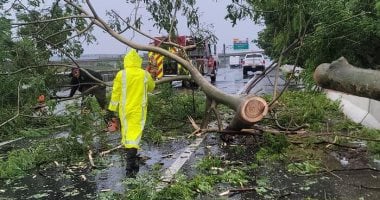Hurricane Irene Strengthens in the Caribbean, Threatens U.S. East Coast

Hurricane Irene has intensified into a Category 3 hurricane on the Saffir-Simpson scale, packing maximum sustained winds of 205 km/h (127 mph) as it moves dangerously close to the Bahamas and the wider Caribbean region. According to the latest update from the U.S. National Hurricane Center (NHC) on Tuesday, the storm poses a significant threat to the U.S. East Coast despite current forecasts suggesting it may not make direct landfall.
The storm is already unleashing heavy rainfall, powerful winds, and dangerous storm surges across parts of the southeastern Bahamas, Turks and Caicos Islands, Haiti, and the Dominican Republic, raising the risk of flash floods and severe coastal damage.
NHC Deputy Director Jamie Rhome warned Americans not to underestimate Irene:
“Many people may think a hurricane offshore won’t have an impact on the U.S. East Coast. That could not be further from the truth. Irene will bring dangerous rip currents, life-threatening surf, and significant coastal flooding.”
Storm Path & U.S. Threat
After battering the Bahamas, Hurricane Irene is forecast to turn northward, tracking between the U.S. East Coast and Bermuda by midweek. Even if the hurricane stays offshore, waves as high as six meters (20 feet) could slam into barrier islands off North Carolina, prompting mandatory evacuations in some vulnerable coastal communities.
The storm has already wreaked havoc in the northern Lesser Antilles and Puerto Rico over the weekend, where strong winds toppled trees, damaged homes, and left over 150,000 households without power, according to local utility company LUMA Energy. While service has been restored to more than 90% of customers, fresh outages were reported on Monday.
Rapid Intensification Linked to Climate Change
Meteorologists have noted that Irene’s intensification was unusually rapid, reaching Category 3 strength within just 24 hours. Dr. Daniel Guilford, a climate scientist, explained:
“Hurricanes are like heat engines. They draw energy from the unusually warm ocean surface and convert it into powerful winds. This kind of rapid intensification is becoming more common with rising sea temperatures.”
Climate experts warn that global warming is increasing the likelihood of stronger, faster-forming storms, making the 2025 Atlantic hurricane season potentially more severe than average. The official hurricane season runs from June through November, but already, Irene has become the first major hurricane of the year.
Historical Context & Recent Disasters
The Caribbean and the U.S. East Coast are still recovering from deadly storms in recent years. In 2017, Hurricane Maria devastated Puerto Rico, leaving lasting scars on infrastructure and communities. More recently, in 2024, Hurricane Helen killed more than 200 people across the southeastern United States.
With Irene now gathering strength over unusually warm Atlantic waters, authorities stress the need for preparedness, early evacuation, and strict adherence to official warnings.
Although forecasts suggest Hurricane Irene may not make a direct U.S. landfall, the storm is already creating life-threatening conditions along the East Coast. From North Carolina’s Outer Banks to Florida and up through New England, millions are urged to remain on high alert.
Follow the latest updates on U.S News, World, and Breaking News for continuous coverage of Hurricane Irene and its impact on the Caribbean and the United States.




